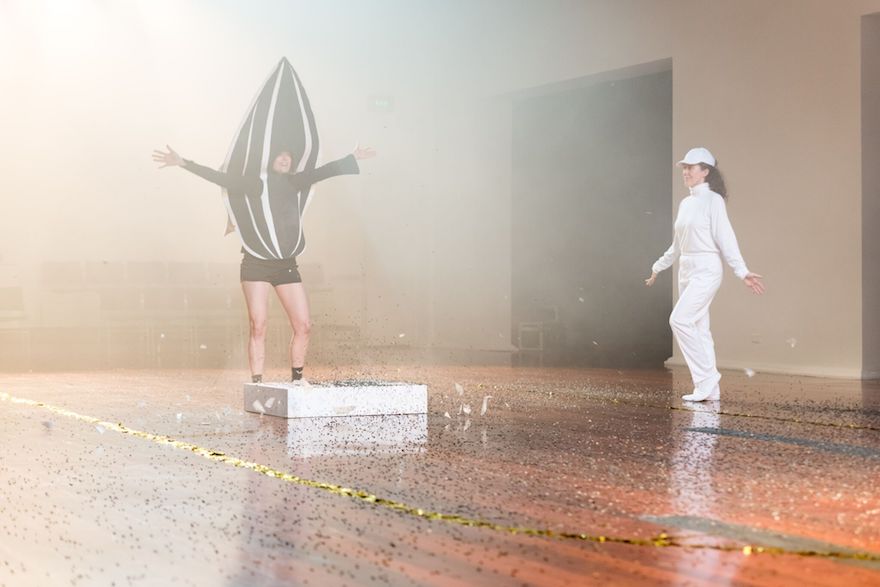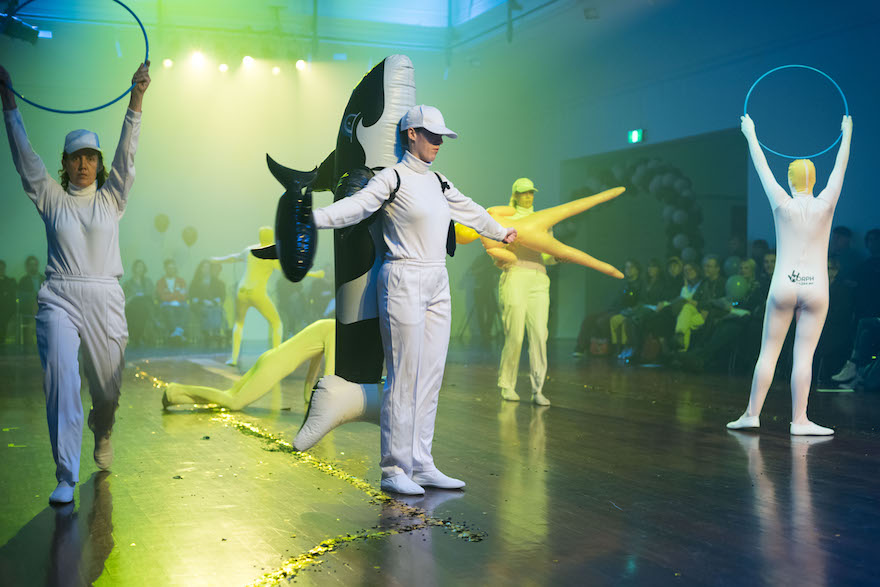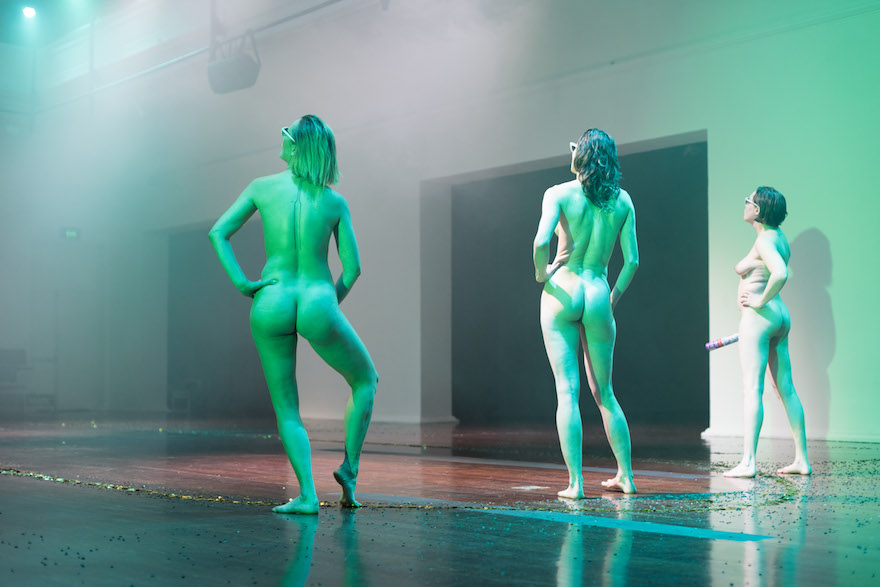Review: Aphids, Howl ·
Perth Institute of Contemporary Arts, Perth, 27 July ·
Review by Jonathan W. Marshall ·
Howl, by Australian contemporary art company Aphids, is an enormously enjoyable homage to art controversies, mostly from the last 20 years, which is joyously staged as an incongruous, camp fashion parade. The pieces featured are not necessarily well known, even to those in the arts, so the printed program offers a much-appreciated guide. The triumph of the show is that the three central performers effectively embody, in their staging and physicality, fifteen different moments in art.
The piece functions as a performative essay in art history and debates around censorship and artist responsibility. In staging the work, creators and performers Lz Dunn, Lara Thoms and Willoh S Weiland reclaim the female nude as a form of empowering self-expression. Howl commences with one of their number embodying Gustave Courbet’s painting of a woman’s crotch, The Origin of the World (1866), after standing upright and meeting the audience’s eyes. Later, the trio turn Lynda Benglis’s infamous nude photograph with a large dildo at her groin, from Artforum magazine (1974), into a carefully choreographed set of four discrete adjustments of that pose, whilst gazing out masterfully from behind sunglasses. These gestures impart a camp and broadly queer ambience.

Other sequences include a giant sunflower seed prancing below us and scattering seeds with gay abandon, before giving us the finger (Ai Weiwei, Sunflower Seeds, 2010). The trio later enter bearing a floppy recreation of an oversized white urinal turned on its side (Marcel Duchamp, Fountain, 1917) and then spout water from pursed lips as if in a Baroque fountain. Captain Cook weaves across the floor on a Segway, his face obscured with a black mask, shaping his fingers into a gun which he points at us (Jason Wing, Australia Was Stolen By Armed Robbery, 2012).
My favourite section saw seven performers appear on stage. Three were dressed as inflatable sex dolls, the masks skewed such that the patterned eyes were not even close to the real eyes beneath. This trio was accompanied by figures in white overalls, some of whom had inflatable killer whales strapped to their backs. All bore either a blue hoop (for the orcas to pass through), a smaller inflatable orca, or a sex doll. They then proceeded to prance, punch and frolic about the stage in a celebration of the erotic meeting of human, object and animal. This alludes to an abortive live-streamed event where artist Amber Swanson was to transform a sex doll, modelled on herself, into an orca (the broadcast was cut).

Howl is fun and provocative, but the selected artworks are extremely diverse. While all attracted discussion at the time of exhibition (and after), only some were subject to censorship. When arrayed together in a celebratory way, Howl coalesces into a polemic in favour of unfettered freedom of speech and the idea that artists need not consider audience sensibilities or safety. Seeds was not actually censored, but was roped off because it became clear that allowing thousands of visitors to mingle freely in the same pile of breakable ceramic seeds for weeks was becoming dangerous. To draw close links between this and the treatment of photographer Connie Petrillo, who police effectively abducted because concerns had been raised regarding the nude photographs of her children, is misleading.
While I hugely enjoyed fêting these artworks, running through these pieces as a homage simplifies complex issues. Although much uninformed commentary suggests otherwise, complaints subsequently published by feminist critics and editors Annette Michelson and Rosalind Krauss against Benglis are not without merit.
By purchasing an advertisement rather than seeking critical coverage, Benglis did indeed have her image published without it being subject to editorial review. The editors were therefore justified in claiming that the subversion of their control required “critical analysis” and that Benglis’s act of “self promotion” could — at least potentially — be seen as an affront to recent feminist critiques and advances in the depiction of women in media and art. Rosalind Krauss later curated the landmark exhibition of Surrealist photography, L’amour fou (1986) which included a profusion of nude feminine forms juxtaposed with dildos and phallic symbols, notably works by Hans Bellmer and Pierre Moliner. She was no anti-porn puritan.

In short, while Howl is fantastic, it does not offer a coherent alternative history of art (as some have claimed). Moreover, inventive and fantasmatic though it is, the visual allusions to the artworks are not always ideal, given that many in the audience are unlikely to be familiar with the originals. Cook’s Segway ride recalls Daniel Boyd’s We Call Them Pirates Out Here (2006) and related works by Gordon Bennet, more than it does Wing’s 2012 bronze bust. The Petrillo work denoted here (Esse Quam Videri) is incorrectly dated to when criminal proceedings began against Petrillo in 1995 but it is actually from 2014. It was not involved in the prosecution, nor, indeed, is it as visually sophisticated in depicting the ambiguous drama of children’s games as Vanished Innocence, Petrillo’s wonderful 2008 collaboration with her daughter.
To some extent, though, these are quibbles. As a work of “Live Art,” the strength of Howl lies in its ambiguous incarnation as a staged physical allusion to something which is not actually present in the performance itself. Bodies are offered as substitutes, often compelling ones, but the largely flat, unaffected presentation means that the audience always has the niggling sense that something else is going on beneath this surface. Howl destabilises and provokes more than it preaches, and in this it is a triumph.
Note/disclaimer: Jonathan W. Marshall chaired a 2008 forum in Fotofreo which featured Petrillo, and in 2014, the photomedia series “Meat Fence” by Justin Spiers with Jonathan W. Marshall, was presented at the Perth Centre of Photography as part of a program alongside Connie Petrillo’s “Esse Quam Videri”.
Photos: Aaron Claringbold.
To find out more about the artworks referred to above see:
Gustave Courbet, Origin du monde (1866), http://www.musee-orsay.fr/en/collections/works-in-focus/search/commentaire/commentaire_id/the-origin-of-the-world-3122.html
Lynda Benglis, “Artforum” advertisement for exhibition with Robert Morris (1974), http://www.artnet.com/magazine_pre2000/index/ratcliff/ratcliff6-13-97.asp https://www.metmuseum.org/blogs/in-circulation/2015/ad-art
Rosalind Krauss, L’amour fou: Photography & Surrealism (1986), https://monoskop.org/images/9/96/Krauss_Rosalind_1985_Photography_in_the_Service_of_Surrealism.pdf
Ai Weiwei, Seeds (2010), https://www.tate.org.uk/whats-on/tate-modern/exhibition/unilever-series/unilever-series-ai-weiwei-sunflower-seeds https://www.theguardian.com/artanddesign/2010/oct/15/tate-modern-sunflower-seeds-ban
Marcel Duchamp, Fountain (1917), https://www.tate.org.uk/art/artworks/duchamp-fountain-t07573
Jason Wing, Australia Was Stolen By Armed Robbery (2012; alternative version 2013), https://nga.gov.au/defyingempire/artists.cfm?artistirn=37727 ; https://www.smh.com.au/entertainment/art-and-design/artists-dark-mask-over-the-past-portrays-captain-cook-as-a-crook-20121003-26zs2.html
Daniel Boyd, We Call Them Pirates Out Here (2006), https://www.theaustralian.com.au/arts/review/we-call-them-priates-out-here/news-story/56a4d1e93d24bb32fc9f5774282bb749?sv=2e048c6b6f48af53e97f2b7f0d10cd9a; https://www.mca.com.au/artists-works/works/2006.25/
Gordon Bennet, Possession Island (Abstract), (1991), https://www.mca.com.au/artists-works/works/2016.16/
Connie Petrillo, Esse Quam Videri (2014) http://www.gothamstudios.org/connie-petrillo.html https://www.artlink.com.au/articles/196/crossing-the-fine-line-the-case-of-concetta-petril/ http://www.metaphorimages.com/wordpress/?p=6083 http://www.gothamstudios.org/uploads/6/4/5/1/64511063/connie_petrillo_cv__full__2015.doc
Amber Hawk Swanson, Amber Doll > Tilikum (2011), https://amberhawkswanson.com/artwork/2938405.html
Justin Spiers with Jonathan W. Marshall, “Meat Fence” (2014), https://www.academia.edu/6107525/Meat_Fence_curated_critical_photomedia_exhibition_catalogue_Perth_Centre_for_Photography_Feb_2014 https://www.academia.edu/36423362/Trophies_Remain_The_history_of_New_Zealand_resource_extraction_and_the_Meat_Fence_photo-project
Like what you're reading? Support Seesaw.






